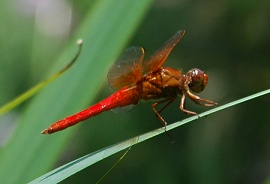
Neon Skimmer, Libellula croceipennis
The lily pond end of the water garden (the other end is an artificial
stream in the shade) provides both deep and shallow water with good plant cover for amphibians and
insects to reproduce. We are now able to maintain the water level with collected rainwater, which
is better for the wildlife. Because we want to encourage amphibians, especially, we don't have fish
in the pond. Two frog species and one toad species reproduce successfully here, as do dragonflies
and damselflies of several species. The plant species include water lily, water iris (both blue and
yellow) and pickerelweed. |
|
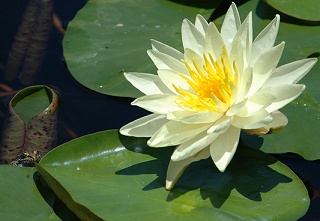
Two young leopard frogs (you can see
only the eyes of one) clinging to a water lily leaf. This lily is a pale yellow that bleaches to
cream on its second day in the sun; we also have a pure white and a lovely pink waterlily.
|
|
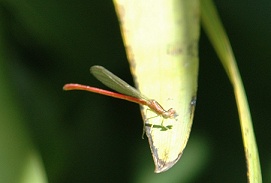
Red Damselfly resting on iris leaf. Damselflies fold
their wings back, besides being smaller than dragonflies. The red ones hang out at the pond; the
males are this brilliant red; the females slightly duller, sometimes almost tan. We have others in
the woods that are dark, or dark striped with blue, as well as brilliant electric-blue
ones.
|
|
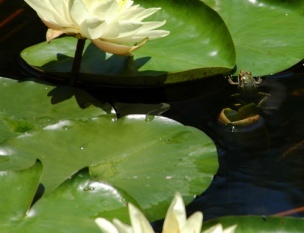
Young leopard frog hanging in the water. These young
frogs are either the southern leopard frog, Rana utricularia, or plains leopard frog, R.
blairi, but so far this spring I haven't been able to see the defining characteristic because
they're too fast. In previous years, most have been the plains leopard frog, which has a sort of
"dogleg" in its dorsolateral ridges.
|
|
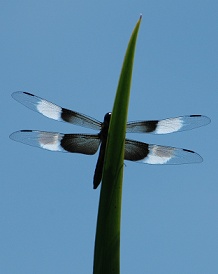
A male Widow Skimmer, Libellula
luctuosa on his favorite perch, from which he can see his territory.
|
|
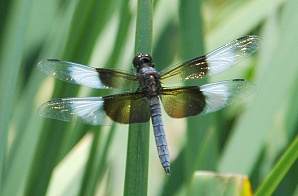
Male Widow Skimmer, dorsal view. This individual
patrols the pond in bright weather. The abdomen in full sun can look almost white, but in the shade
looks a rich blue. The female of this species (pictured on the
June 2003 page) is black with shimmering gold markings and
wing iridescence.
|
|
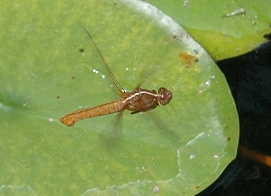 The female laying eggs is the Neon Skimmer,
Libellula corceipennis. The female laying eggs is the Neon Skimmer,
Libellula corceipennis.
Female Neon Skimmers glow honey-golden in the sun, when they
hover over open water and then "scoop" water and emerging eggs with their abdomens, sometimes
flinging a droplet of water with an egg in high enough to make it out of the pond. The males hover
nearby or actually chase the females. This one (on the right) is approaching open water to lay her
eggs. This one (below) had dipped her abdomen into the water and is about to
scoop-and-splash.
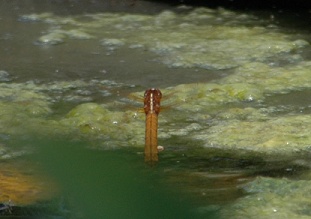
|
|
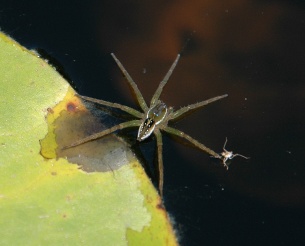
This water spider has only seven legs left, but can
still walk on water. I'm wondering if the sad little husk by her right middle leg is her boy
toy.
|
|
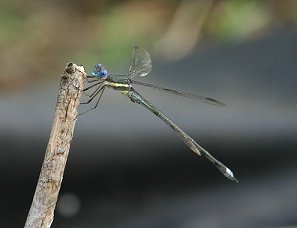
Great Spreadwing, Archilestes grandis male...the
bluest eyes you've ever seen. This species is the largest damselfly in the United States. This
picture would've been impossible without manual focus control.
|
|
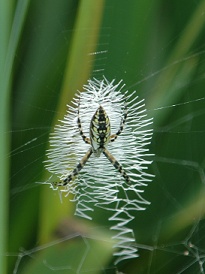
Into every paradise for dragonflies come dangers...in
this case the big black-and-yellow orb weavers, Argiope aurantia, who start out between the
blades of the iris, and later spin webs that span from the iris to a young tree within a few feet
of the pond. Such webs block the favorite patrol patterns of the males, and even a neon skimmer can
be trapped and eaten.
|


![]()
